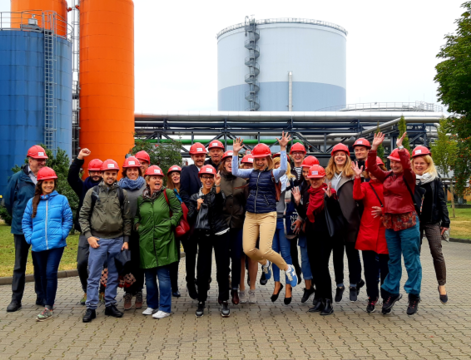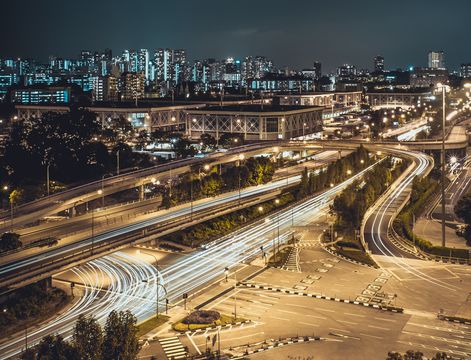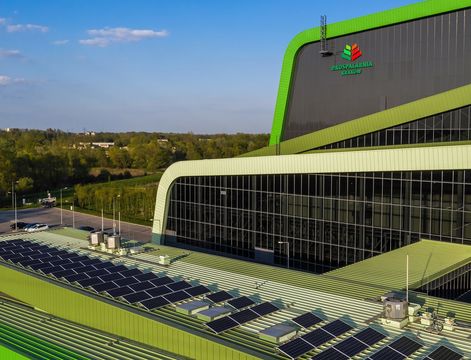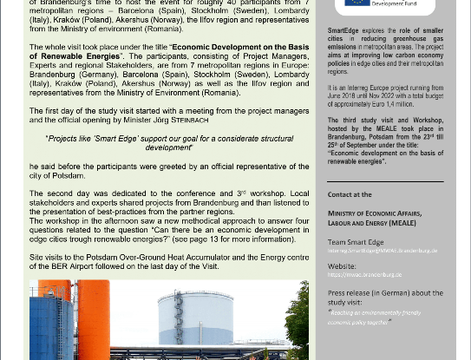
SmartEdge Final Conference 20th of May 2022
The SmartEdge Final Conference 20th of May was arranged as a digital conference. The aim was sharing knowlegde about low carbon policy development.
SmartEdge will address the potential for greenhouse gas emission reductions that lie in the development of smaller cities within metropolitan areas. Edge cities are an integral part of the existing metropolitan fabric and may be laboratories for smart, green, economic solutions and have the opportunity to play a crucial role in the low carbon economy. The overall objective of the project is to improve low carbon economy policies in edge cities and their metropolitan regions. To achieve this, eight partners from the metropolitan areas of Akershus, Barcelona, Brandenburg, Ilfov, Krakow, Milano and Stockholm, and the Romanian Ministry of Environment will exchange experience, transfer good practices and facilitate learning between the partners on innovative tools for urban planning. Transport and buildings represent the lion’s share of our emissions, and may be reduced through efficient policies on a local and regional level. Smart Edge will in particular explore the potential for local renewable energy production, reduction of emissions from transport through renewable energy and energy systems ad reduction of emissions from buildings through renewable energy and energy systems. SmartEdge is expected to result in improved low carbon economy policies in edge cities and their metropolitan regions. In particular the metropolitan regions will prepare and implement action plans to improved selected seven policy instuments by sharing solutions for Integrated Strategic Planning for edge cities and their regions, providing tools and methods for multi-level governance and participatory planning, actively including the edge cities and other stakeholders in the metropolitan areas, and develop policy recommendations. 205 MEUR in Structural funds and 124,8 MEUR in other fundsof other funds are estimated to be influenced by the project.
€1,080,306.00
Low-carbon economy
We are happy to announce that we have just completed our second project meeting and workshop in the SmartEdge project. The venue for the exchange of experiance and workshop was the magnificent Village Museum in Buchuresti, while the site visit the next day was in Magurele, Ilfov. The theme for our workshop was participatory urban and energy planning.
When mapping the theme in the partnership, we identified three interesting findings:
1) Participation in urban and energy planning (the citizen dialog) is for the most part handled at local level, by the municipalities themselves.
2) Several of the regions support the local level with recourses (money / time) to support participation, or facilitate network meetings / seminars to set the agenda and make municipalities share with each other how to facilitate participation in planning.
3) Several regions see participation relevant for urban planning, while the field is not well elaborated within energy planning.
A general outtake of the WS is that it is necessary to work cross-disciplinary with participatory planning, and make it relevant for climate and energy planning. To reach our climate goals we need to work together anc cross the different sectors.
When planning for tomorrow’s urban areas and the energy transition ahead, the participatory perspective must be taken into account. One example: Since November 2018 “the yellow wests” have been demonstrating in Paris and France. The manifistations started as a reaction against the higher tax on fossil fuels, but arguments for more purchasing power and greater democracy was also addressed. This shows that participatory planning is relevant when working with both climate measures (gas tax or other measures) and land-use planning, and these themes are interconnected and should be dealt with together.
The Regional Plan for Climate and Energy aims to develop policies for common climate actions that should be implemented. Urban sprawl and increase in GHG emissions are challenges that need to be adressed in order to develop the six appointed edge towns into regional independent cities with good urban quality. Thus, the plan is closely linked to the polycentric strategy (one core and 6 edge cities) described in the "Joint Regional Plan for Land Use and Transportation in Oslo and Akershus". This plan sets the foundation for reducing the need for cars and transitioning to a mobility pattern based on walking, cycling and public transport. The population increase and growth has led to a transition towards these edge cities, and the Regional Plan for Climate and Energy will contribute to develop these towns into good and climate-friendly living areas by reducing GHG emissions and facilitating sustainable growth for a low carbon economy. In order for the county to be a leading sustainable region, it is imperative to find common strategies and policies. To significantly reduce GHG emissions, all levels of government need good practices for collaboration, involvement and implementation of strategies and measures. The regional plan and subsequent action plans will be important tools in the development of the six edge cities alongside other regional measures initiated by Akershus county.
The OP ERDF Brandenburg 2014-2020 focusses on innovation, competitiveness of SMEs, CO2 reduction strategies and integrated urban and rural development. Especially Priority Axis 3 (159.817.499 EUR) aims at supporting the shift towards a low-carbon economy in all sectors. Four Specific Objectives (SO) in PA 3 will directly benefit from the project (funding related to IP):
1. SO 9 "Improving energy efficiency in private enterprises" (Investment priority (IP) 4b with 15,8 Mio EUR),
2. SO 10 "Increasing energy efficiency and the use of renewable energy in public buildings and infrastructure as well as in urban districts" (IP 4c with 25,8 Mio. EUR),
3. SO 13 "Developing strategies, district development concepts and related implementation measures to reduce CO2 emissions" (IP 4e with 34 Mio. EUR) and
4. SO 14 "Improving the CO2 balance of the transport sector" (IP 4e).
With regard to urban planning, Brandenburg ERDF OP will also benefit in PA 4 "Integrated development of urban and rural areas" adressing sustainable use of natural resources in cities. Edge cities are of high relevance as they act as intermediaries between fast growing Berlin Brandenburg. Owing to the strong trend of suburbanization in the capital region with its challenges in key climate-relevant areas such as supply and use of electrical energy, heating/cooling or public and private transport the need of edge cities for new concepts of CO2 reduction in all sectors of the economy is especially high.
Catalonia's ERDF OP focuses on knowledge and innovation, entrepreneurship and green economy. Axis 4 (128.962.375 EUR) promotes facilitating the transition to low-carbon economy in all sectors, and includes two Investment Priorities that will be directly addressed in the project:
- IP 4.3 "Support energy efficiency, intelligent management of energy and the use of renewable energies in public infrastructure ", with specific objective 4.3.1 of "Improving energy efficiency and reducing CO2 emissions in the buildings, infrastructures and public services";
- IP 4.5 "Promoting carbon reduction strategies for all types of land, especially in urban areas, including the promotion of urban mobility, multimodal and sustainable adaptation measures with a mitigation effect", and its specific objective 4.5.1 of "Promotion of sustainable urban mobility".
Furthermore, Axis 6 (131.971.497 EUR) focusses on resource efficiency and the protection of the environment, with priorities including the improvement of urban environment and revitalisation of cities.
Edge cities are key in the transition to low-carbon economies, but the policy instrument does not specifically tackle them. For example, in Barcelona the use of private vehicles is especially high for the connections between edge cities and the centre. It is essential to focus carbon emissions reduction in edge cities, and SmartEdge can improve the ERDF of developing this specific approach.
RUFS 2050 is both a physical plan and a regional development program. Its vision is to become Europe’s most attractive metropolitan region. RUFS is basis for transport infrastructure investments in the region.
Continuous investments in energy efficiency and mitigation measures since the 1990’s have made the Stockholm region to a forerunner regarding climate protection. The region has achieved a de-coupling of economic growth and GHG emissions. Under the objective of “becoming a resource efficient region without climate impact”, RUFS 2050 sets out ambitious energy and climate goals. The current direct CO2 eq emissions are 2.7 tons/capita*year, goal for 2030 is 1.5 ton and zero-net emissions by 2045. The transport sector stands for 55 percent of the county’s emissions of 6 million tons CO2 (2014).
Another central development feature of RUFS 2050 is to evolve a polycentric region with one central core and 8 regional cores (edge cities). These are growth poles where a big part of future development shall take place (housing, public services and enterprises). Their sustainable development is one of eight major priorities. To bring the region to net zero emission levels together with smart land use solutions contribute to a low carbon society. These commitments need a broad stakeholder approach and a lot of investments particularly in the regional cores. SmartEdge can provide valuable input both in terms of new knowledge and implementation practices of other European regions.
The OP of Lombardy focuses on three main goals in order to implement a regional strategy coherent with a “smart, sustainable and inclusive” growth:
1. Supporting the competitiveness of the Regional SMEs
2. Efficient use of resources
3. Inclusive development for "critical" Areas
The fourth activity line (Asse IV) implementing these goals, with a budget of 194,6 ml€ – 20.05 % of the whole ERDF funding – is “Support the transition to a low-carbon economy in all sectors” with the goal to help cut carbon emissions and make up the shortfall compared with the target of the Europe 2020 strategy over the period 2014-2020.
Its main goal is to support measures to reduce energy consumption in the public sector (public buildings and public lighting) and interventions designed to promote strategies for cutting carbon emissions in urban and metropolitan areas, in keeping with the relevant regional instruments.
More efforts are required to kick start structural support measures such as the identification of bottlenecks that may be represented by the lack of multi-level governance co-ordination between Egde Cities and Region through the role of the Metropolitan City.
Thorugh SmartEdge we aim to achieve this through the use of renewable energy sources, innovation in the monitoring process of thermal heating systems in buildings, implementation and use of new digital tools and improvement of the energy efficiency performance of buildings by increasing the maintenance of thermal plants.
The Regional Operational Programme (ROP) for the 2014-2020 period for Małopolska means up to 2.87 billion euro from the European Funds. The programme consists of thirteen one-fund priority axes. Among them, the largest amounts are planned to be spent on innovation, energy policy and transport infrastructure. In the context of the project, we will address objective of the Priority Axis 4 which is to create conditions for a sustainable growth in the region, with account being taken of the aspects of a modern energy sector and an urban transport sector, ensuring energy security for the region’s residents and improving the quality of their life while, at the same time, respecting with the principles of environmental protection. Funding allocated to this Priority Axis is 420 mln euro.
Goals for axis are for the first time implemented on such – metropolitan – scale. For the first time on such scale, we deal with the issue of sustainable transport and mobility. Why it needs to be improved? The ROP contains a good framework for projects, however it is necessary to develop detailed recommendations - guidelines for creating better projects aiming for solving issues common for the whole Metropolitan Area. The ROP lacks recommendations for wide, system solutions, which would have contribute to consistent growth within the metropolis, using the potential of Cracow and edge cities.
This strategy describes and provides essential data and information on climate variations that have affected and will affect Romania; it is also providing support information and relevant data on the overall contribution of each sector to GHG emissions and how human activity (through productive or consumption / use processes) together with natural processes leads to these emissions.
Lower units and operators in lower energy consumption sectors have as targets the reduction of emissions by 19% in 2020 compared to the level of 2005. Also, Romania has pledged to increase the share of energy from renewable sources in energy consumption to 18% in 2005 to 24% by 2020.
Better cooperation with stakeholder groups and the civil society will contribute to a change of mentality and approach, leading to the much desired shift in between theory and practice. Education efforts must support individuals and societies to make informed decisions about climate change.
Climate. Why improve: The policy instrument doesn't have any particular focus on the role of edge cities in facilitating transition to low carbon economy, and this perspective needs to be strengthened on the basis of good practices freom the other partners .
Changing our own behavior can limit climate change. By switching to energy sources that don't release greenhouse gases, increasing the energy efficiency of our homes and offices, and driving less, we can reduce our effect on the climate and limit climate change.

The SmartEdge Final Conference 20th of May was arranged as a digital conference. The aim was sharing knowlegde about low carbon policy development.

The Interreg project SmartEdge is coming to an end and the final conference will be digital, co-hosted by partner Stockholm and leadpartner Viken.

All SmartEdge-partners have taken large steps in implementing their Action Plan. This is a update of status on the actions plans for the project partners.

This is a short summary – a project-guide – with highlights from Phase 1 of the Interreg project SmartEdge.

Save the date for the last two workshops in the SmartEdge project.

The Covid-19 pandemic and the following shut-down of society, resulted in a temporary dip in the emissions. 6 months later, the emissions are increasing.
ENEA and Milan Metropolitan City signed an agreement for the realisation of a “One Stop Shop”.

An analysis from Krakow have shown that legislative regulations should be combined with locally tailor-made instruments.

Our newsletter is out! Check it out and see what we have learned in our WS in Brandenburg.
The 4th workshop for the SmartEdge prosject is postponed, due to the Corona virus.